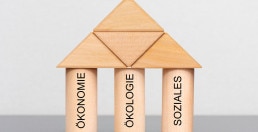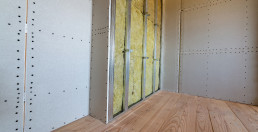The construction industry is currently facing several hurdles. Shortages of resources are leading to long waiting times and significant cost increases. It’s no wonder that in the construction sector, there is an increasing focus on ways to conserve resources and energy, as well as finding long-lasting, sustainable solutions. In this blog post, we’ll provide you with a clear overview of the subject of sustainable construction.
Sustainable construction: definition
Everyone is talking about the environment. But what is sustainable construction? It’s all about the awareness that resources are finite, which means that we must use them as carefully as possible. The aim of ‘alternative’ construction is therefore to use as little energy and as few resources as possible and to actively support the environment.
Three-pillar model and sustainability in the construction industry
When we talk about the subject of sustainability, factors are often assessed in terms of the three-pillar model of sustainable development. The model says that successful sustainable development is only possible if environmental, economic and social aspects are dealt with simultaneously and in equal measure. The three factors therefore always influence one another.

This principle can also be used to assess sustainability in the construction industry or in the construction of a particular property. The sustainability factors should be taken into consideration as much as possible across a building’s entire life cycle. The life cycle of a building does not just include its actual service life, for example as a residential or office building. It also includes its construction and eventually its deconstruction when it can no longer be used and must be demolished.
Sustainable construction and living
The construction of sustainable buildings doesn’t just begin when their foundations are laid. At the planning stage of a construction project, it is important to carefully consider which environmentally friendly measures will be adopted during construction, which building materials will be used and which technologies will be installed, so that the building can be used in a way that conserves resources as much as possible.
Only after the planning stage does the actual construction work begin, during which other factors must be taken into consideration to guarantee sustainability.
Planning: checklist for sustainable construction
There are a number of different factors that absolutely must be considered at the planning stage of a sustainable building. A good initial design is crucial in order to calculate a budget and save costs in the long run.
Checklist for sustainability in architecture:
#1 Type of building
- plan a structure that is as simple and compact as possible
- find a climate-friendly shape and size for the building
- consider the direction of the building towards the sun to make optimal use of its warmth and daylight
- build in a way that is as accessible as possible and neutral in terms of the building’s usage
- use closed insulation sleeves and minimal thermal bridging for reduced heat loss and low energy consumption
#2 Construction type and materials
- focus on good insulation (and acoustic insulation)
- install high-quality, airtight windows in optimum locations
- windows with sun protection protect against overheating, no air conditioning necessary
- use high-quality, durable materials, building products and construction methods
- use sustainable, non-polluting, recyclable construction materials with a good environmental footprint
#3 Sustainable construction/design
- ensure installations are easily accessible
- rely on simple supporting structures
#4 Equipment in the building
- smart technological equipment, e.g. for controlling and measuring ventilation, lighting, heating etc.
- self-sufficient energy supply using photovoltaic and solar systems
- sustainable heating systems (heat pumps, wood pellet heating)
- use water-saving technologies
- accessible, timeless sanitary equipment
- if possible: green buildings
Implementation of green building
Sustainability in architectural planning is not enough: during the construction stage itself, measures can be taken to ensure more sustainability in the construction industry.
Take note of the following points for a sustainable construction site:
- ideally collaborate with a sustainable construction company
- ensure smooth construction processes to keep workloads to a minimum
- buy construction materials locally to avoid long transportation routes and the associated high costs and CO2 emissions
- use energy as efficiently as possible during construction and minimise CO2 emissions (turn off machines when not in use etc.)
- reuse resources
- invest in high-quality, long-lasting tools
- minimise risk to all parties involved in construction, for example by providing personal protective equipment (PPE) such as safety helmets, safety glasses, hearing protection etc.

Sustainability of construction materials
The sustainability of a building is inevitably reflected in the materials that are used during its construction. It is therefore vitally important to use sustainable materials that ensure a long service life for the building and which can then be easily disposed of or reused.
Natural construction materials
There are many new and innovative construction materials. However, when it comes to environmentally friendly construction, it is worth relying on well-known natural materials. These have been used by people for thousands of years to construct buildings. A lot of these materials are extremely durable – think about structures such as the Egyptian pyramids that are over four thousand years old or the archaeological remains from Roman times.
Natural stone
Natural stone refers to stone that is untreated, as opposed to clay or brick. It can be extracted from quarries with relatively low energy requirements. Natural stone can be used for building external façades as well as inside the home. Popular types of stone include granite, limestone, slate, sandstone and marble.
Clay, loam and brick
Clay and loam can fulfil a range of functions in the construction industry, for example as filler or plaster. However, they are most commonly used as bricks: the raw material is placed into moulds, pressed and then fired until a firm stone in a standardised size is formed.
Wood, cork, reed
Wood and cork can be used as visually appealing, renewable and robust raw materials for façade construction. Reed grows on the banks of lakes and rivers as well as in marshy wetlands. In its dried state, reed is mostly used for roofing.
Sustainable concrete
Concrete is also a natural product that is made from the raw materials cement, i.e. limestone and clay, as well as sand or gravel and water. It can be cast in different shapes and is therefore very flexible. However, the components of concrete are finite resources. The extraction of these raw materials and the subsequent production of concrete produces a lot of carbon dioxide and also requires a large amount of energy. In order to get round these problems, concrete can be recycled. In Germany, the recycled material is mostly used in road construction.
Environmentally friendly insulating material
Good insulation is an absolute must for environmentally friendly housing and sustainable construction, as it traps heat in the building. On the other hand, moisture can gather on uninsulated, cold walls, which can lead to moisture damage and mould formation.
Affordable, petroleum-based insulating materials are usually used in construction. However, there are a range of sustainable and renewable alternatives.
Sustainable construction – examples of environmentally friendly insulating materials:
- glass wool
- stone wool
- wood fibre, wood wool
- cork
- hemp and jute
- straw and grass
- cellulose
- gravel

Quality seal for sustainable buildings
If sustainability has been considered during the construction of a new building or the renovation of an existing building, this can be made official and proven with different certifications. The most important awards include the Quality Seal for Sustainable Construction (QNG) from the German federal government and the DGNB certificates in platinum, gold, silver and bronze from the German Sustainable Building Council (DGNB e.V.).
Energy-efficient and sustainable construction: conclusion
Sustainability and energy efficiency have become increasingly important in recent years and will continue to be relevant in everyone’s day-to-day lives in the future. These developments can also be seen in the construction industry where sustainability has often been neglected in the past. Today, new and innovative technologies are merging with well-established practices and construction materials to take the industry into the future. Sustainable construction can be mastered – with benefits for people and the environment.
At uvex, we are also aware of the enormous importance of sustainability. That’s why we have added #protectingplanet to our corporate mission of protecting people. This sustainability label stands behind all uvex group brands. In our eyes, occupational health and safety includes not only direct protection from injury through PPE, but also the preservation of our nature and environment. That’s why uvex has committed itself to providing you with products that reflect our commitment to ecological and social responsibility. Sustainable construction can be mastered – to the benefit of people and the environment.